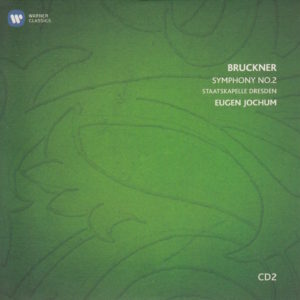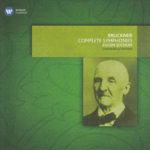 This morning’s conductor of Anton Bruckner’s “Symphony of Pauses” (Symphony No. 2 in C Minor, WAB 102) is, once again, Eugen Jochum (1902-1987).
This morning’s conductor of Anton Bruckner’s “Symphony of Pauses” (Symphony No. 2 in C Minor, WAB 102) is, once again, Eugen Jochum (1902-1987).
I first encountered Mr. Jochum on Day 6 of my 144-day journey.
I first listened to his conducting of the Staatskapelle Dresden orchestra (which is what I’m hearing right now) on Day 7.
I’ve been wondering about the nickname “Symphony of Pauses.” So, before I got any further into my listening, I looked it up.
According to its entry on Wikipedia,
The Symphony No. 2 in C minor of 1872 was revised in 1873, 1876, 1877 and 1892. It is sometimes called the Symphony of Pauses for its dramatic use of whole-orchestra rests, which accentuate the form of the piece. In the Carragan edition of the 1872 version, the Scherzo is placed second and the Adagio third. It is in the same key as No. 1.
So there you have it: Whole-orchestra rests.
 I’m just going to dive right in this morning.
I’m just going to dive right in this morning.
Here are the objective aspects of today’s listening fare:
Bruckner’s Symphony No. 2 in C Minor, composed in 1872
Eugen Jochum conducts
Staatskapelle Dresden plays
The version used is the 1877 version, edited by Leopold Nowak
The symphony clocks in at 52:38
This was recorded in 1980, in Dresden, Germany
Jochum was 78 when he conducted it
Bruckner was 48 when he composed it
It was released on the Warner Classics Music Label
Bruckner wrote his symphonies in four parts. The time breakdown of this one (Symphony No. 2 in C Minor, 1877 Nowak Edition), from this particular conductor (Jochum) and this particular orchestra (Staatskapelle Dresden) is as follows:
Moderato………….18:00
Andante…………….14:57
Scherzo……………….6:34
Finale…………………12:46
Total: 52:38
Okay. Now for the subjective aspects to this morning’s listening:
My Rating:
Recording quality: 4 (slight tape hiss, some ambient movements)
Overall musicianship: 4
CD liner notes: 3 (very short overview essay in English, German, Italian, French)
How does this make me feel: 3
The first thing I noticed about this recording of Bruckner’s Symphony No. 2 in C Minor is its tempo, especially in my beloved Second Movement (Andante in this recording). The part that I look forward to every time is the pizzicato and French horn melody that begins, here, at the 2:21 mark. The French horn enters quickly at about the 2:25 mark. But then the tempo seems slowed, almost to a crawl.
These instruments and that haunting melodic theme return at around the 6:00 mark.
Another difference: the tone of the French horn isn’t as warm as it has been in previous recordings.
The effect of what sounds like a slowing of the tempo of this melodic strain – and using a French horn with a more muffled tone – is that it transforms the Second Movement from something light and magical into something dark and morose, almost dirge-like.
The French horn in this version reminds me of a trumpet playing Taps. It has that kind of mood to it.
Strange. Really strange.
This recording by Jochum makes me feel sad. World weary.
It may well be that I’m not hearing the tempo correctly, and that it’s not slowed in any way.
But it feels that way for some reason.
The hell do I know? I’m no musicologist.
Someone posted this clip on YouTube. It’s Jochum conducting Bruckner’s Symphony No. 2 in C Minor, Movement II. I don’t think this clip is music I heard yesterday and today. The orchestra (Symphonieorchester des Bayerischen Rundfunks) listed on Youtube is different from the two Jochum CD box sets I have. The date of the recording differs from I have, too. (This YouTube uploader says this is from 1967.)
But it’ll give you an idea of what I mean regarding the pizzicato and French horn melody that begins around the 2:20 mark and repeats several times in Movement II.
It may also give you an idea of the tempo, which is slower – to my ears – than what I’ve heard from other conductors.
